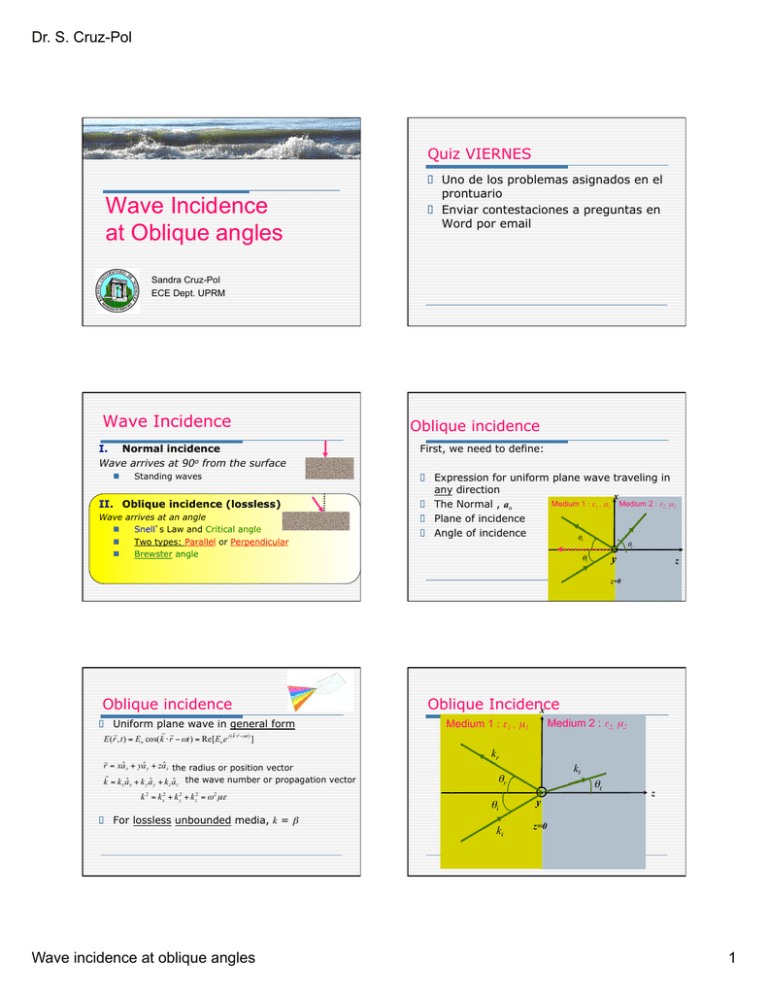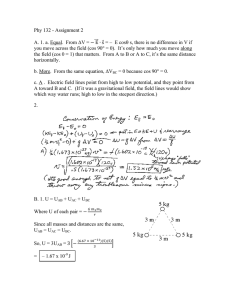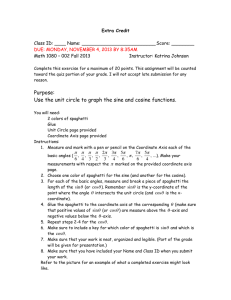Wave Incidence at Oblique angles
advertisement

Dr. S. Cruz-Pol Quiz VIERNES Wave Incidence at Oblique angles o Uno de los problemas asignados en el prontuario o Enviar contestaciones a preguntas en Word por email Sandra Cruz-Pol ECE Dept. UPRM Wave Incidence I. Normal incidence Wave arrives at 90o from the surface n Standing waves II. Oblique incidence (lossless) Wave arrives at an angle n Snell s Law and Critical angle n Two types: Parallel or Perpendicular n Brewster angle Oblique incidence First, we need to define: o Expression for uniform plane wave traveling in any direction x Medium 1 : ε1 , µ1 Medium 2 : ε2, µ2 o The Normal , an o Plane of incidence o Angle of incidence θ r θt y θi z z=0 Oblique incidence o Uniform plane wave in general form E (r , t ) = Eo cos( k ⋅ r − ωt ) = Re[Eo e j ( k ⋅r −ωt ) ] r = xaˆ x + yaˆ y + zaˆ z the radius or position vector k = k x aˆ x + k y aˆ y + k z aˆ z the wave number or propagation vector k 2 = k x2 + k y2 + k z2 = ω 2 µε o For lossless unbounded media, k = β Wave incidence at oblique angles Oblique Incidence x Medium 2 : ε2, µ2 Medium 1 : ε1 , µ1 kr kt θr θi ki θt y z z=0 1 Dr. S. Cruz-Pol Look at the direction of travel Expression for Waves x Medium 2 : ε2, µ2 Medium 1 : ε1 , µ1 kr Er = Ero cos( k rx x + k rz z − ωt ) kt θr θt z y θi kix ki Ei = Eio cos( kix x + kiz z − ωt ) θi z=0 ki E must be Continuous Ei ( z = 0) + Er ( z = 0) = Et ( z = 0) !i = ! r = !t = ! kix = krx = ktx = kx kiy = kry = kty = ky kix So 700nm is not always red!! kix = krx β1 sin θi = β1 sin θ r Critical angle, θc k iz = β1 cosθ i Snell Law kix = ktx o Equating, we get !1 sin " i = !2 sin " t or Also written as, n1 sin ! i = n2 sin ! t where, the index of refraction of a medium, ni , is defined as the ratio of the phase velocity in free space (c) to the phase velocity in the medium. n = ε 1 sin θ c = …All is reflected o When θt the refracted wave flows along the surface and no energy is transmitted into medium 2. o The value of the angle of incidence corresponding to this is called critical angle, θc. o If θi > θc, the incident wave is totally reflected. k i = k ix2 + k iz2 = β1 = ω µ1ε 1 k ix = β1 sin θ i From this we know that frequency is a property of the wave. So is color. Give example of bathing suit. =90o, where kiz kiz Tangential Et = Eto cos( ktx x + ktz z − ωt ) = n2 sin θ t [θ t = 90 o ] n1 n2 ε = r2 n1 ε r1 (for µ1 = µ 2 ) Example sin ! c = sin 42 o = !r 2 sin 90 o !r1 4 (1) = .67 9 sin 50 o = .77 = .67 (sin??o ) r1 Fiber optics o Light can be guided with total reflections through thin dielectric rods made of glass or transparent plastic, known as optical fibers. o The only power lost is due to reflections at the input and output ends and absorption by the fiber material (not perfect dielectric). sin 40 o = .64 = .67 (sin 73o ) Wave incidence at oblique angles 2 Dr. S. Cruz-Pol Optical fibers have cylindrical fiber core with index of refraction nf, surrounded by another cylinder of lower, nc < nf , called a cladding. Exercise: optical fiber o An optical fiber (in air) is made of fiber core with index of refraction of 1.52 and a cladding with an index of refraction of 1.49. o Find the acceptance sin ! a ! angle: [Figure from Ulaby, 1999] o For total reflection: Acceptance angle n sin θ 3 ≥ sin θ c = 2 n1 θ 2 + θ 3 = 90 o sin θ a ≤ (n 2f − nc2 ) Er Et Ers = Ero (cos θ r xˆ + sin θ r zˆ )e − jβ1 ( x sinθ r − z cosθ r ) H rs = − Ero η1 kr e − jβ1 ( x sinθ r − z cosθ r ) yˆ Ei Ets = Eto (cos θ t xˆ − sin θ t zˆ )e − jβ 2 ( x sinθt + z cosθt ) H ts = Eto η2 Which components are tangent to the interface between two surfaces? o y and x At z = 0 (interface): x Medium 1 : ε1 , µ1 e − jβ1 ( x sinθi + z cosθi ) yˆ θi ki θt y z z=0 Medium 2 : ε2, µ2 Reflection and Transmission Coefficients: Parallel Incidence o Reflection E η cosθ t − η1 cosθ i Γ|| = ro = 2 Eio η 2 cosθ t + η1 cosθ i E 2η 2 cosθ i τ || = to = Eio η 2 cosθ t + η1 cosθ i τ || = (1 + Γ|| ) cosθ i cosθ t Wave incidence at oblique angles xˆ : Eio (cos θ i )e − jβ1 ( x sinθi + z cosθi ) + Ero (cos θ r )e − jβ1 ( x sinθ r − z cosθ r ) = Eto (cos θ t )e − jβ 2 ( x sinθt + z cosθt ) kt θr e − jβ 2 ( x sinθt + z cosθt ) yˆ where (1.52 "1.49 2 ) 1 Equating for continuity, the tangent fields o It s defined as E is || to incidence plane η1 = Answer: 17.5 degrees n0 Eis = Eio (cos θ i xˆ − sin θ i zˆ )e − jβ1 ( x sinθi + z cosθi ) Eio n0 2 Parallel polarization H is = (n 2f " nc2 ) z yˆ : Eio η1 e − jβ1 ( x sinθi + z cosθi ) − Ero η1 e − jβ1 ( x sinθi − z cosθi ) = Eto η2 e − jβ 2 ( x sinθt + z cosθt ) xˆ : Eio cosθ i + Ero cosθ r = Eto cosθ t yˆ : Eio η1 − Ero η1 = Eto η2 Reflection and Transmission Coefficients: Perpendicular Incidence Γ⊥ = Ero η 2 cos θ i − η1 cos θ t = Eio η 2 cos θ i + η1 cos θ t τ⊥ = Eto 2η 2 cos θ i = Eio η 2 cos θ i + η1 cos θ t 1 + Γ⊥ = τ ⊥ 3 Dr. S. Cruz-Pol Java Animation Exercise o http://www.amanogawa.com/archive/ Oblique/Oblique-2.html A plane wave in air with Ei = yˆ10e − j (3 x + 4 z ) [V / m] Is incident upon planar surface of nonmagnetic dielectric material with εr=4, on z>0, Find o The polarization of the incident wave o The angle of incidence o The time-domain expressions for the reflected electric and magnetic fields. o The average power density carried by the wave in the dielectric medium. Brewster angle, θB Exercise o Is defined as the incidence angle at which the reflection coefficient is 0 (all transmission). A plane wave in free space with Ei = (10 yˆ + 5zˆ) cos(ωt + 2 y − 4 z )[V / m] Is incident upon planar surface of nonmagnetic lossless dielectric material with εr=4, on z>0, Find o The polarization of the incident wave o The angle of incidence and transmission o The reflection and transmission coefficients. o The E field in reflected and in dielectric Answers : o Brewster angle 26.6 o , 12.9 o , − 0.295, 0.65, (−2.946 yˆ + 1.47 zˆ ) cos(ωt + 2 y + 4 z ), Γ|| = η 2 cosθ t − η1 cosθ B =0 η 2 cosθ t + η1 cosθ B η 2 cosθ t − η1 cosθ B = 0 sin θ B|| = 1 − (ε 1µ 2 / ε 2 µ1 ) 1 − (ε 1 / ε 2 ) 2 * θB is known as the polarizing angle o The Brewster angle does not exist for perpendicular polarization for nonmagnetic materials. (6.5 yˆ + 3.2 zˆ ) cos(ωt + 2 y − 8.7 z ),63.4 o Reflection vs. Incidence angle. Exercise (Brewster angle) Reflection vs. incidence angle for different types of soil and parallel or perpendicular polarization. A wave in air is incident upon the flat boundary of a nonmagnetic soil medium with εr=4, at θi=50o. o Find reflection and transmission coefficients for both incident polarizations, and the Brewster angle. o Answers: Γ|| = −0.16, τ || = 0.58 Γ⊥ = −0.48, τ ⊥ = 0.52 EMAG Wave incidence at oblique angles θ B|| = 63.4o 4 Dr. S. Cruz-Pol Summary Property Reflection coefficient Transmission coefficient Relation Normal Incidence η −η Γ= 2 1 η 2 + η1 τ= 2η 2 i η 2 + η1t τ = 1+ Γ Power Reflectivity R= Γ Power Transmissivity T = 1− R Snell s Law: 2 n sin θ t = 1 sin θ i n2 Perpendicular Parallel Γ⊥ = η cosθ t − η1 cosθ i η 2 cosθ i − η1 cosθ t Γ|| = 2 η 2 cosθ t + η1 cosθ i η 2 cosθ i + η1 cosθ t τ⊥ = 2η 2 cosθ i 2η 2 cosθ i τ = η 2 cosθ i + η1 cosθ t || η 2 cosθ t + η1 cosθ i τ ⊥ =1 + Γ⊥ R⊥ = Γ⊥ 2 T⊥ = 1 − R⊥ τ || = (1 + Γ|| ) R|| = Γ|| cosθ i cosθ t 2 T|| = 1 − R|| where n2 = µ r 2ε r 2 Wave incidence at oblique angles 5





